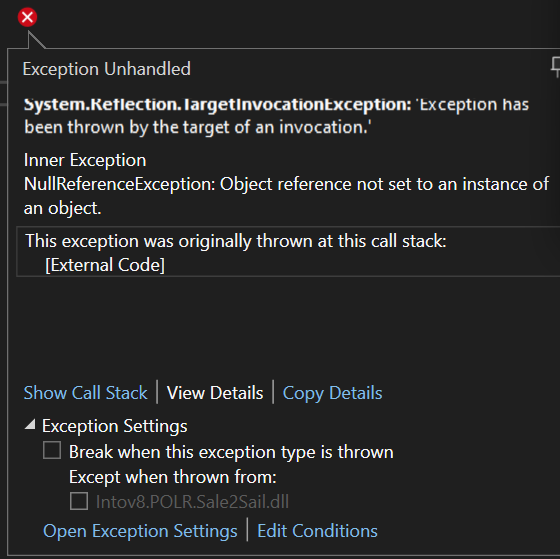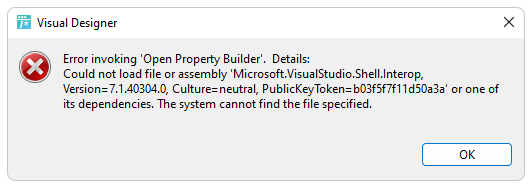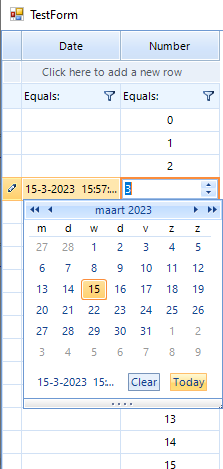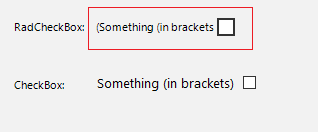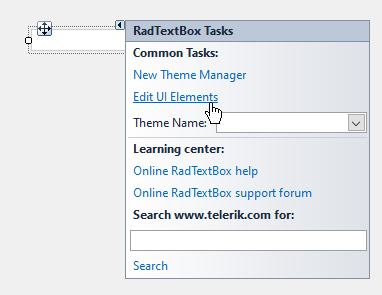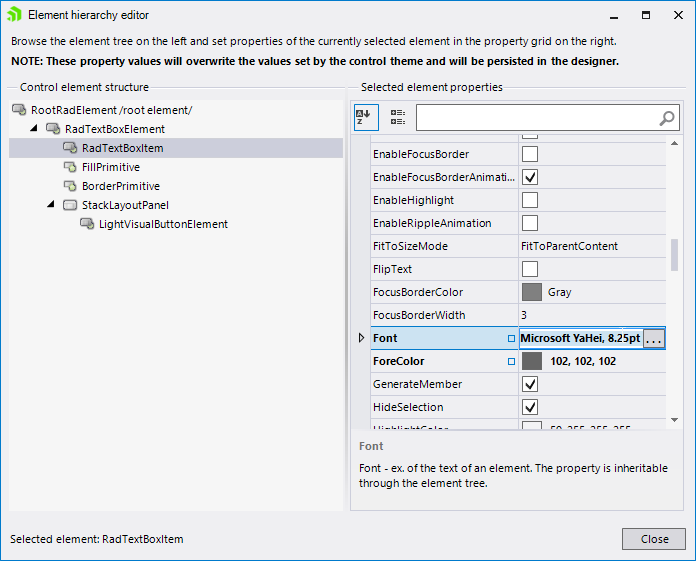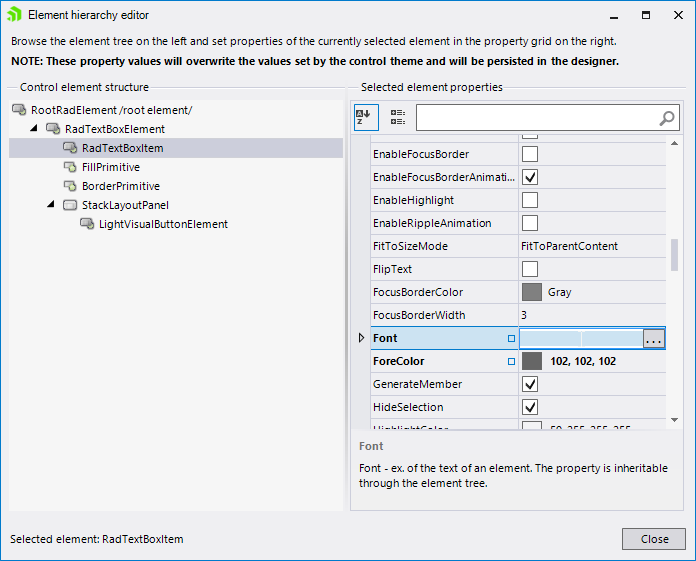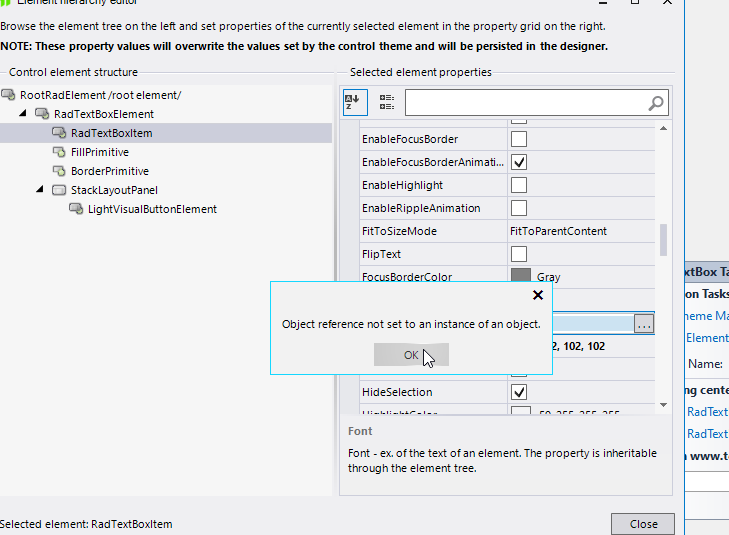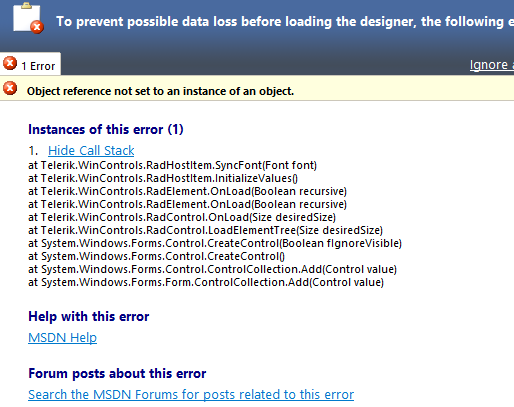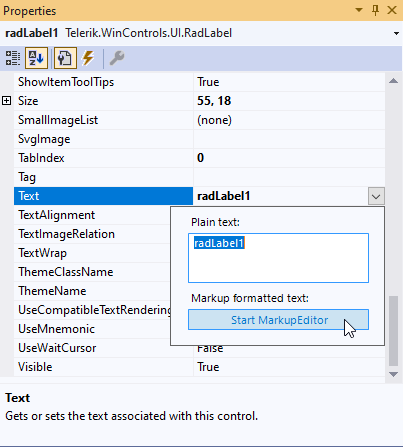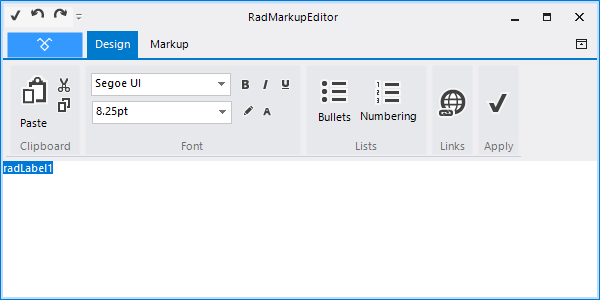Zooming in will throw an Exception that crashes the program.
The ZoomLevel needed to cause the exception is dependent on the area of the RadMap selected.
Provider: BingRestMapProvider
ImagerySet AerialWithLabelsOnDemand
Zooming in over Antarctica, Exception thrown zooming in at MapElement.ZoomLevel 14.
Zooming in over Australia, Exception thrown zooming in at MapElement.ZoomLevel 21.
The designer tries to load the assembly and throws the following error:
Just to report a minor typo:
FitlerViewTextCategoryItemCreatedEventArgs, in Telerik.WinControls.UI.FilterView
public partial class RadForm1 : Telerik.WinControls.UI.RadForm
{
public RadForm1()
{
InitializeComponent();
this.SizeChanged += RadForm1_SizeChanged;
this.timer1.Start();
}
private void RadForm1_SizeChanged(object sender, EventArgs e)
{
this.Text = this.Size.ToString();
}
private void timer1_Tick(object sender, EventArgs e)
{
if (this.WindowState == FormWindowState.Minimized)
{
this.WindowState = FormWindowState.Normal;
}
else
{
this.WindowState = FormWindowState.Minimized;
}
}
}Repro steps:
- Create a RadVirtualGrid with:
- A column with a nullable DateTime
- Another column with a string or number.
- Fill it with one or more rows. The DateTimes remain null.
- Edit a DateTime cell, open the dropdown:
- Click op button [Today], the date/time in the cell changes.
- Click [Tab], the focuses moves to the next cell, but the dropdown remains open:
- Click somewhere else in the grid or form, an Exception is thrown:
System.NullReferenceException: Object reference not set to an instance of an object. at Telerik.WinControls.UI.RadDateTimePickerCalendar.popupControl_Closing(Object sender, RadPopupClosingEventArgs args)Expected behavior:
- The dropdown closes after moving to another cell.
- No exception occurs.
To reproduce:
this.radCheckBox1.Text = "Something (in brackets)";
this.radCheckBox1.RightToLeft = System.Windows.Forms.RightToLeft.Yes;Add a RadTextBox on the form and open its smart tag:
Open the editor for the font and select the entire text:
Then, press Del:
When you try to close the editor, an error occurs:
However, the Font is already serialized as null:
As a result, the designer can't be opened any more:
Presently none of the controls can be navigated to using the TAB key or the shift TAB combination.
For example, in this picture I would like to be able to go from the Verdana font to the size 12 font using TAB key controls. I would like to be able to do this for all controls within the editor. I have asked support and presently this wouldn't be possible.
To be accessible and compliant with our organizations standards, the search bar that can be enabled in the gridview should be accessible by pressing TAB and shift TAB. Right now the only way to select the search by keyboard is pressing Control F, but the up/down arrows and the search settings cog wheel cannot be accessed via the keyboard.
As of right now, the user cannot also select the column headers using the keyboard, which in turn means you cannot sort by a column with a keyboard.

Background: With many people having moved to working remotely, collaboration is a much larger part of any enterprise applications. As such, it would be highly beneficial to add real time collaboration capabilities to editor controls, more specifically the RadRichTextEditor control. It would work similarly to how MS Word works when more than one user is editing a document at the same time.
Scenario: Assume you have and WinForms application where there is a form that contains a RadRichTextEditor. The content for this control is populated from a centralized database. This content is editable by users of the application. Lets say that you have two users (User A and User B) editing this content at the same time. Currently, User A cannot see what User B is doing in real-time, and vice-versa. Each time one of the users saves the content, it will overwrite any changes made by the other user.
Desired outcome: If the users in the above scenario are using MS Word, each user would see that someone else is currently editing the document and the other user's changes would be displayed in real-time. This same outcome should be made more readily available with the Telerik editors, primarily the RadRichTextEditor, so that when two users are editing the same content, they would see each others' changes in real-time.
I know this is possible using SignalR and a bit of code, but I think it would be beneficial for the RadRichTextEditor to have better "out of the box" support for this feature.
I am aware of a web-based control that has this feature. Specifically, the CKEditor (https://ckeditor.com/) control has the features I am requesting. However, I am looking at WinForms as opposed to web.
RadVirtualGrid is created to support a million records or more. Still it contains some "heavy" operations like CopySelection/CutSelection/Paste which can take a long time.
I would like to intercept these methods so I can show a "Please wait"-window during the operation. Furthermore I have the need to set a flag to true when such a operation is executing.
The Cut operations of the RadVirtualGrid does not work.
When the SelectionMode is set to FullRowSelect, MultiSelect = true, and multiple rows are selected, the loop goes something like this:
// Pseudo code:
for(int rowIndex = firstRow; rowIndex <= lastRow; rowIndex++)
{
AddRowToClipboardData(rowIndex)
UserDeletedRow(rowIndex);
}- Lets say 10 rows are selected, only the even rows get copied. First row 0 is copied and deleted. When row 0 is deleted, all rows move a position down. So when copying row 1, it is actually row 2 that is copyied.
- When cutting all rows, in my case an exception is thrown, because a rowIndex larger than the number of rows is referred to.
- When cutting to multiple clipboard formats, the second format will not contain the original selected data, because it has already been deleted.
My suggestion:
- First copy all the data and formats to the clipboard.
- Then delete the selected rows.
The assembly is required for our RadMarkupEditor using the IE rendering engine. It allows you to specify HTML-like text formatting at design time in the Properties window of Visual studio:

